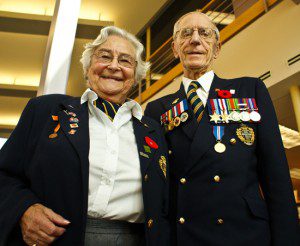
A close veteran friend of mine died this week. Bruce Evans, winner of the Governor General’s Caring Canadian Award, served in the Second World War with the 1st Hussars tank regiment. He landed in Normandy and was wounded on D-Day 1944; but he rejoined the 6th Armoured Regiment in time to help liberate Holland in 1944-45. His reason for serving was simple.
“It wasn’t patriotism that drove us,” Evans said. “Our job was to … liberate Europe,” and he was always mindful of the regiment’s motto, “today not tomorrow.”
Little more than 20 years old at the time, Bruce Evans hadn’t even voted in an election when he landed to fight in Europe. And yet he was struck by mortar shrapnel on June 6, 1944, protested being sent back to England for treatment, and was back in action on the continent weeks later.
My guess is that Bruce Evans would, therefore, be appalled at the voter turnout statistics from Monday’s byelections in B.C., Alberta and Ontario. The latest figures indicate that in all three byelections fewer than half those eligible to vote, bothered to do so. In the Victoria, B.C., riding, less than 43.9 per cent of the constituency voted. In Calgary Centre less than 30 per cent of those of voting age felt motivated to cast ballots. And in the Ontario riding of Durham, it was less than 36 per cent showing up at polling stations.
To a certain extent I can understand why young people don’t bother to vote. We don’t make it relevant for them. But any veteran, anyone fighting for equality among men and women, any civic-minded individual at all would be offended by such apathy.
At best, such statistics tell Canadians that the people they send to the House of Commons, provincial legislatures or municipal councils don’t really represent the majority of those living in their ridings. In other words, even the winners in the three ridings – Murray Rankin (in Victoria), Joan Crockatt (in Calgary) and Erin O’Toole (in Durham) – are not truly “representatives” since less than half eligible adults believe enough in them to cast ballots. At worst, such stats say Canadians have little respect.
“They’re all bums,” some of you say. “Why vote for any of them?”
All the more reason to put someone on Parliament Hill, at Queen’s Park or in Township Council who isn’t. As far as exciting young people about elections? Well, I have exposure to some of them in my college classrooms/labs every day. On Monday I asked a few, if they lived in one of the byelection ridings, would they have voted? Wouldn’t waste the time, one said. One vote doesn’t matter, another said. And worst of all, many said they didn’t care.
Perhaps we have to rattle the youth cage a little bit, make elections “in your face” for a change. Maybe if politicians told young voters they were considering taxing texting time… that time allowed on Facebook was contingent on the number of community hours donated… and that ownership of new fashion would be predicated by the recycling of old… they might get youth attention and youth votes.

Some years ago, I invited veteran Bruce Evans to engage the young. One autumn (to acknowledge Canada’s role in liberating them during the war) the Dutch had sent thousands of tulip bulbs to be planted at Canadian schoolyards. But with little tangible explanation, the students couldn’t figure out why. I asked Evans, who had been part of the liberation of the Netherlands, if he would meet a group of Grade 8 kids. I also invited Dutch-born Canadian Anne Pompili, a teenager in Holland in 1945, to remember how freedom was restored by young Canadians, such as Bruce Evans.
“I was 13 years old when German planes bombed Rotterdam,” Pompili said. “They arrested my father and occupied our home.”
As he and his tank crew fought through the villages and towns in the winter and spring of 1945, Evans remembered how grateful Dutch citizens had been to be given back their freedom.
“During the liberation of Apeldoorn (Holland), the tank battles caused a lot of destruction,” tank commander Evans said. “At one point, to protect ourselves from snipers, we moved our tank between two damaged houses. Suddenly, I noticed this tapping sound on the outside of the tank… There was a Dutch family handing up a bowl of fruit to us. It was all they had.”
The Grade 8 students were moved. They understood that freedom had been lost and restored. They then realized why the Dutch had sent tulip bulbs to Canadian schools. As Anne and Bruce and the students planted the bulbs in the school flower garden, that fall morning, one student captured the moment.
“I can’t picture myself going through what Bruce and Anne did,” the student said. “I don’t think I could have made the decisions they did.”
Such revelations might be valuable the next time Canadians – of any age – are invited to vote in an election.